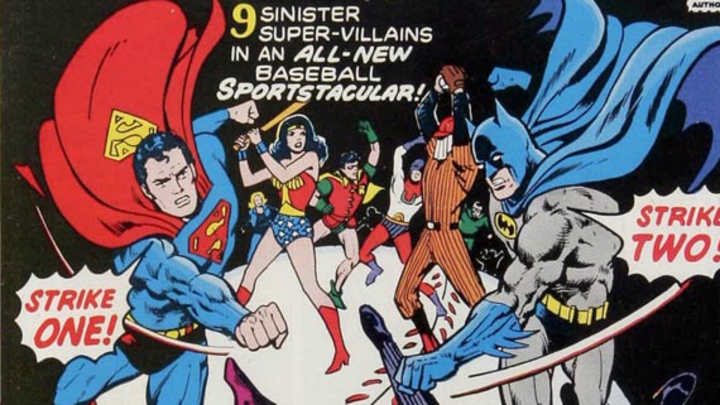Superhero Baseball: By the Numbers

Ever wondered which superhero would make the best athlete? Would Superman’s strength make him unbeatable? What about the Flash’s speed? Luckily, one comic answered these questions nearly 40 years ago by pitting the Justice League against their arch-nemeses for a game of baseball.
Back in the early 1960s, legendary creators Julie Schwartz and Carmine Infantino filled five issues of The Brave and the Bold with “Strange Sports,” a mini-series about phantom boxers, gorillas that played baseball, and other science fiction-meets-athletics premises. (Schwartz and Infantino are responsible for many of DC Comics most enduring characters, like the Flash and Batgirl.) But “Strange Sports” would not be revisited for many years, most recently in a single issue, DC Super-Stars #10, published in December 1976.
This particular comic features the Sportsmaster (who you may remember from TV shows like Batman: The Brave and the Bold or Young Justice) trying to prove a point: Villains don’t always lose. To test his theory, he decides to face the heroes with home field advantage — both figuratively and literally — by forcing them to play baseball.
The game proceeds tied, 8-8, into the ninth inning. Things then get wacky, with both heroes and villains using a variety of powers and equipment in an attempt to break the tie.
To illustrate the ups and downs of the game, I’ve used a stat called WPA, or Win Probability Added. Very simply, this stat measures how each play hurts or helps that team’s chances of winning. For instance, Black Canary hit a leadoff home run to lead off the fourth inning, with the heroes already leading 3-1. Due to their lead, the heroes already had a 73 percent chance of going on to win the game. But after the home run, that chance went up to 82 percent. So the play added 9%, or +9% WPA.
In the bottom half of that same inning, however, the Sportsmaster hit a two-run home run, dropping the heroes chance of winning to 47 percent and giving his prediction that villains would triumph a 53 percent chance of coming true.
This graph charts the hijinks of the ninth inning along the probability that the superheroes would win. It starts at 50 percent, when the heroes entered the ninth inning tied, and ends at 100 percent, when the villains fall one run short in the bottom of the ninth, clinching the Justice League’s victory:
Click on the graph to see it full sized!
Ironically, the heroes win the game after Plastic Man does a “grandly villainous” trick by morphing his foot into the shape of first base. Sportsmaster, mistaking Plastic Man’s foot for the base, misses first and is tagged out.
Here’s the statistical results for each hero, including their WPA contribution to their team’s victory:
Wonder Woman, 2B: 2-6, 1 R, 0 RBI, 1 double, +7% WPA
Robin, LF: 2-5, 3 R, 1 RBI, 1 double: -6% WPA
Kid Flash, SS: 2-5. 2 R, 2 RBI, 1 double, -9% WPA
Batman, C: 5-5, 2 RBI, +49% WPA
Green Arrow, 3B: 3-5, 1 R, 4 RBI, 1 double, +34% WPA
Huntress, CF: 1-4. 1 R, 1 RBI, 1 double, +8% WPA
Plastic Man, 1B: 1-5, -9% WPA
Black Canary, RF: 3-5, 2 R, 1 RBI, 2 doubles, 1 HR, +12% WPA
Superman, P: 2-4, 1 R, 2 RBI, -35% WPA
Superheroes and athletes have appeared together in the funny pages since the earliest days of comic books. In one special comic, an evil alien overlord forced Superman to fight Muhammad Ali— with the future of humanity in the balance! In another, Spider-Man and the Hulk had to save the Winter Olympics. And who could forget the time Charles Barkley challenged Godzilla to a game of one-on-one? But in terms of a legit sports/superheroes team-up, nothing comes close to the baseball game in DC Super-Stars.



